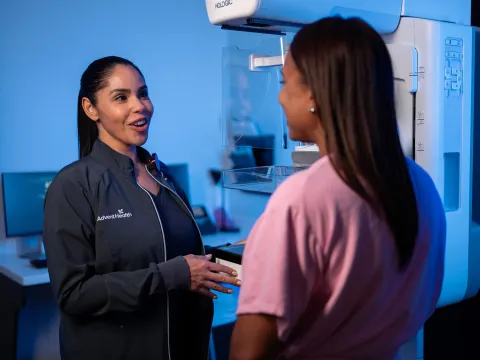- AdventHealth

Choose the health content that’s right for you, and get it delivered right in your inbox.
When you feel healthy, it’s tempting to delay annual checkups and screenings. No symptoms means no concerns, right?
Unfortunately, we know that underlying medical conditions often go undetected for too long without regular preventive care. Even with the busiest schedule, your health should always be a priority.
Breast cancer is the second-leading cause of cancer death in women in the U.S. and annual mammograms are still the top recommended screening for women, allowing the earliest possible detection of breast cancer — even before you experience symptoms.
The Key to Lifesaving Early Detection
A mammogram is such a powerful tool because of its ability to catch breast cancer early. In fact, it can detect breast cancer up to two years before a tumor can be felt by you or your doctor.
Catching cancer early means:
-
Therapies like breast conservation therapy will be most effective
-
Treatment can begin early, possibly before the cancer spreads to other parts of your body
-
You’ll have the best possible chance for a cure
Many women with breast cancer have no symptoms. According to the American Cancer Society, many decades of research show women who have regular mammograms are more likely to have breast cancer found early, are less likely to need aggressive treatment like surgery or chemotherapy and are more likely to be cured.
Screening vs. Diagnostic Mammograms
Mammography uses X-rays to take images of your breasts. Screening mammograms and diagnostic mammograms use the same equipment and procedures; they differ in the number and type of images made.
Screening mammograms are for women who have no signs of breast cancer such as a lump, pain or change in breast size or shape. These simple appointments are often complete in 30 minutes or less. Breast cancers found during screening exams are more likely to be smaller and still confined to the breast.
Diagnostic mammograms are prescribed when a screening mammogram shows an area of concern. They take more detailed images from different angles to help your care team make the most accurate diagnosis.
Screening if You’re High-Risk
If your risk for breast cancer is higher than average, your care team may recommend additional screenings that include magnetic resonance imaging (MRI) and ultrasound. Although these can be combined with a mammogram, they are not a replacement.
MRI
Instead of X-rays, an MRI scan uses a magnetic field to make images. Although an MRI can find breast cancer that mammography misses, it doesn’t find all breast cancers. An MRI is effective for women whose health history includes:
-
BRCA1 or BRCA2 gene mutation
-
Immediate family member — mother, sister or child — with BRCA1 or BRCA2
-
Radiation treatment to the chest between ages 10 and 30
Ultrasound
This exam uses sound waves to make an image. Women who are pregnant or at very high risk for breast cancer, and who can’t have an MRI or be exposed to X-rays, can benefit from an ultrasound. It’s also better at finding breast cancers in women who have dense breast tissue, which is more difficult to diagnose using mammography.
Know Your Risk for Breast Cancer
It’s important to know your risk for breast cancer. Some risk factors you can control, like your weight and lifestyle. Others you can’t, including:
-
Age
-
Density of breast tissue
-
Family history of breast cancer
-
First menstrual period before age 12
-
Genetic mutations BRCA1 and BRCA2
-
History of fibroids or other benign breast conditions
-
Race and ethnicity
When you understand the breast cancer risk factors you can control, you can manage them better with the guidance of physicians who have your whole health in mind.
Feel Empowered With Preventive Care
If you’re between the ages of 20 and 40, you should have a clinical breast exam by your doctor at least every three years. If you’re 40 or older, an annual screening mammogram may be recommended by your doctor.
If you haven’t had a mammogram in the past year and you’re over age 40 with no abnormal symptoms, you can self-refer for a screening mammogram. Simply make an appointment at an AdventHealth imaging center and have the results sent directly to you.
Our breast cancer screenings are focused on one thing: protecting your whole health. Your long-term well-being is important to us — and taking the first step is up to you. Make an appointment for your screening mammogram today.




